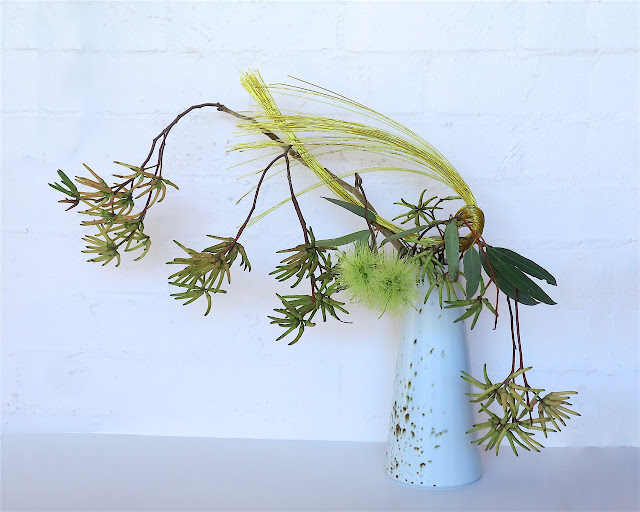Yes, Spike! In the early evening I was about to go out to water the more delicate northern hemisphere plants, after the second consecutive rather warm dry day, only to find him at the door. It has been the kind of weather that brings the flying ants out to swarm, which may have been another reason for Spike to come into the garden.
However, a little later I discovered he was thirsty. I have been keeping the Hydrangeas well watered, given the weather. So their saucers were full of water...
...at just at the right height for a thirsty Echidna!
The tree is about 10m high and, as this photo shows, has a large spreading branch. A couple of weeks ago I noticed the newly-opened flowers from our bathroom window.
They have such an interesting form and a really lovely honey-like fragrance, which I enjoy when I walk past the ikebana. The flowers, in the photo above, were well above my head height and I was only able to cut one small stem with three opened flowers.
The rest of the flowers were still "in bud" and each single flower in the cluster is covered by a long narrow operculum, which cover the greenish-yellow stamens, as you can see in this photo.
The cascading form of the side branches lent themselves to a nageire (tall vase) style ikebana, to which I added some more gold mizuhiki. The vase is by the Victorian potter Arnaud Barraud.








Just wanted to say thank you again for this wonderful blog that you write.
ReplyDeleteGreetings Arteth. Thank you for your comment. I am pleased that you enjoy these postings. It is good to share ikebana and the different flavour the Australian environment brings.
DeleteRegards,
Christopher
Thank you for giving us so much useful information that we can use. If I had to choose, this is one of the best essays I have ever read. My absolute favorite of your blogs is this one. Basically what I was looking for. I hope you keep making great things.office relocation melbourne
ReplyDelete